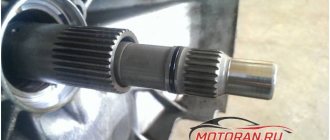The automatic gearbox is the most important and expensive component in a modern car after the engine. To ensure proper movement of the vehicle and stable operation of the device, it is necessary to promptly change the oil in the automatic transmission. Untimely maintenance can damage this unit, which can lead to expensive repairs. In this review we will tell you how, why and why you need to change this technical fluid in the box.
How does oil work in an automatic transmission?
First, let’s remember the principle of operation of the “automatic machine” in a car. This device connects the engine and wheels of the car, converting the torque of the power unit into the energy necessary for movement. In an automatic transmission, the engine crankshaft is connected to a torque converter (GDT), the output shaft of which works with the transmission mechanisms. The latter set the wheels of the car in motion.
Transmission oil, ATF (Automatic Transmission Fluid), is required for the following reasons:
- Ensures normal operation of the node. It transmits torque evenly to the transmission. Thanks to him, the car moves without jerking and smoothly. ATF acts as a kind of clutch pedal in an automatic transmission. The oil uses its body to activate the torque converter parts.
- Actuating mechanism. Having received a command from the ECU (electronic control unit), ATF exerts pressure on certain channels in the device (hydraulic plate), thereby changing gears.
- Removes heat. As a result of the operation of the mechanisms, the metal heats up. Transmission fluid (oil) removes heat into the crankcase, thereby stabilizing the operation of the device.
- Lubrication function. The metal parts of the gearbox are in constant motion, interacting with other components of the unit. They require constant lubrication. This increases their service life, reduces wear, and improves adhesive properties. ATF acts as a lubricant.
- Removal of waste product. When the mechanism operates, metal debris inevitably forms: dust, burrs, shavings, etc. Oil, with the help of additives added to it, helps the device get rid of unnecessary accumulation, facilitating the operation of the mechanisms.
The purpose of the transmission fluid may vary depending on the type of gearbox installed. In a robotic box, for example Getrag 6DCT250, it is necessary for cooling and lubrication of the gearbox. The remaining components of the device are cooled by air.
Is it necessary to change the oil in an automatic transmission?
Several years ago, some manufacturers of well-known brands, for example, the famous German triumvirate: Audi, BMW, Mercedes, wanting to attract attention to their products, announced: there is no need to change the oil. This recommendation was written down in the car’s service book.
Car enthusiasts were delighted with this innovation: no one needed extra expenses. However, the practice of subsequent years has shown that a complete oil change in the gearbox must be carried out. Otherwise, even the most perfect mechanism quickly becomes unusable and wears out.
The manufacturers themselves were convinced of this: the number of automatic transmission failures after reaching a significant mileage has increased significantly.
The industry now offers higher quality technical fluids than before. They are able to withstand critical temperatures and work in extreme conditions. However, this is not a reason to save on buying oil.
Traffic intensity and loads on mechanisms, including gearboxes, have increased significantly. Over time, ATF loses its performance qualities necessary for lubrication, cooling, and driving gearbox parts.
If the fluid is not replaced in time, then over time it becomes filled with debris resulting from the friction of metal components: peeled parts of clutches, linings, decomposition products, and wear. Such an abrasive mixture negatively affects gearbox parts, rendering them unusable.
When do you need to change the oil in an automatic transmission?
All manufacturers regulate the period for replacing ATF. It is not the same for cars of different brands. The service range, based on the mileage traveled, is from 50 to 120 thousand km. The same BMW AG, which recently advocated for the eternity of its technical fluid, recommends filling in new oil after 50 thousand kilometers or 3 years of operation of the car.
An oil change for a car with normal operation is carried out when the vehicle reaches 60 thousand kilometers or two years of use.
Such an operation should be carried out not only in accordance with the manufacturers’ recommendations, but even earlier, as the ATP’s working qualities expire.
In areas with high humidity and extreme temperatures, such automatic transmission maintenance should be carried out every 30 thousand km or once a year. It is also necessary to replace the transmission fluid ahead of schedule for cars that are used daily under heavy load.
The operating conditions of the machine should be taken into account:
- climate;
- intensity;
- driving style.
I would like to particularly focus on the last point. Some vehicle owners themselves are to blame for the fact that transmission fluid is produced prematurely. This is facilitated by an aggressive or sporty driving style:
- constant alternation of high-speed acceleration with sharp braking;
- kick-down reception (when starting to move, the gas pedal is all the way to the stop at a traffic light);
- taking sharp turns at high speed.
The listed actions force the mechanisms to work under extreme load. Accordingly, the temperature in the assembly increases and the parts heat up. Under such conditions, the oil quickly loses its service life and viscosity and needs to be changed.
How to determine when it is necessary to change the oil?
It is necessary to regularly inspect the technical fluid and listen to the operation of the vehicle’s mechanisms.
Oil in working condition has a reddish color without various impurities and traces of contamination. To do this, you need to remove the dipstick from the device located in the gearbox.
If the following symptoms are detected, you must immediately fill in new ATF:
- The oil has changed color to dark brown.
- There is a burnt smell when viewing the dipstick.
- The appearance of a constant howl while the car is moving, coming from the automatic transmission. When you switch modes, the sound also changes.
- The oil thins out and leaks begin, causing the level to drop.
- The car jerks when moving.
- Unstable operation (possible slipping) of the gearbox.
- Some modes “disappear”: Drive, Reverse.
Also, on most foreign-made brands, an error appears on the information board indicating a faulty automatic transmission.
Draining oil through the plug
Let's merge! If your box has a drain plug at the bottom, first place some large container under it. Usually, its role is played by cut-off plastic canisters, taking into account that several liters of fluid will come out of the transmission (about 3 to 5). Next, unscrew this drain plug and oil will flow out of the neck by gravity. And now you just have to wait until all the liquid that can leak out, accordingly, flows out. After this, screw the drain plug back on. Count the amount of oil drained from the transmission - you will now need to pour the same amount of new fluid inside.
Repair of automatic transmission 8HP45 on BMW 523i
How to find out what kind of oil was poured into the automatic transmission?
It seems like a simple question, but it can’t always be answered right away. The service book, which indicates the type of product, may be lost, and determining the color of the liquid on the dipstick is problematic. In such cases, you can use the following options:
- in some cases, information is indicated by the manufacturer under the hood on a nameplate;
- call the official representative, dealer;
- find out information on the Internet site.
As a hint, we note the ATF markings used by well-known brands:
- Volkswagen Group - G-052-055, ZF, in extreme cases - ESSO;
- Toyota – ATF Toyota Tire-T;
- BMW – ZF;
- Nissan – Nissan Matic;
- Mercedes – ATF Mercedes.
Original oils are of high quality, but are expensive. In order to save money, we can recommend using a similar product from other manufacturers. To do this, you need to find out the technical parameters: tolerances, viscosity of the original.
Methods for changing the oil in an automatic transmission
If the owner of a car with an automatic transmission does not have the skills in such matters or the desire to engage in such matters, then you should use the services of car service professionals.
Maintenance is carried out using special equipment that, under pressure, introduces new oil into the system, displacing the used one. The advantages of this method are:
- replacement quality;
- ATF changes in full;
- speed of service;
- significant improvement in automatic transmission performance;
- reduction in fuel consumption.
However, there are also negative aspects of such an operation:
- service costs;
- purchasing new oil in increased quantities;
- It is not recommended to carry out such a service on old cars.
The latter is explained by the fact that the “working environment” of the old box is washed away with the waste. It is not a fact that worn-out mechanisms will be able to function normally with fresh oil.
From my own experience
To clearly demonstrate how quickly transmission oil degrades under normal operating conditions, we sent samples taken from the automatic transmissions of Nissan Almera and Datsun mi-DO editorial cars for examination.
The Nissan is equipped with a French 4-speed automatic transmission DP2, and the Datsun is equipped with a Japanese 4-speed Jatco JF414E gearbox. Both cars were filled with factory oil, which was never changed.
Technology for performing work when changing automatic transmission oil yourself
For those who want to save money, there is an option to replace the transmission fluid yourself. If you follow the technology, the work will not cause big problems.
The following nuance must be taken into account. On different brands, the filler necks and drain holes are located in different places. For those who are going to carry out such an operation for the first time, you can go to the Internet and type in the search: how to change the oil in an automatic transmission. There will be a sufficient number of answers for any brand.
Fill the oil through the dipstick
But filler necks are not always found on automatic transmissions, and then the oil is filled using other methods. If your machine is equipped with a dipstick for checking the oil level, then fresh oil is poured through the hole in which this dipstick is located. You found out his location in the car, right? It is often located under the hood of the car, where the engine dipstick is. But there are often other options for its location, so read the manufacturer’s manual.
We believe that the dipstick has been found, and if you did not previously know its location, then you are not tired of searching. Now we take out the dipstick and insert a funnel into the hole where it was just located. This is where we will pour our oil. As for the funnel, by the way, it is unlikely that you will be able to carefully pour oil into the small hole of the dipstick without it; you will need it. If we don’t have one at hand, then if we have decided to do everything on our own, let’s build a funnel with our own hands - from a thin hose and a cut from the neck of a plastic bottle. Scotch tape will help you! And now we fill in the oil using our simple device, after which we return the dipstick to its rightful place.
Partial replacement
There are two ways to change the oil: partially or completely. In the first case, the fluid in the box is renewed, adding better performance characteristics to the overall mixture.
Order of conduct:
- unscrew the crankcase drain cap;
- drain the oil;
- pour the approximate volume of drained liquid through the neck.
In this way, approximately 35% of the total volume is replaced. This saves money on one-time replacement. Car service technicians advise repeating the procedure several times after 400-600 km.
Experts advise carrying out a complete replacement of the ATF, All automotive fuse box diagrams in one place, which will ensure better operation of the gearbox.
Removing the box tray
The second option of draining is more feasible with your own hands, but it already involves serious mechanical intervention - removing the automatic transmission pan. To do this, first, if there is one, remove the pan protection by unscrewing the bolts. Then unscrew the bolts of the box pallet itself, leaving two bolts in the corners at the end to make it easier to remove the pallet. Removed? – Drain the oil from the pan into a separate container and place it under the box - oil will continue to flow from there for some time. We recommend that you wash the tray. And yes, don’t forget to clean the magnets in it, because they catch metal particles from wearing mechanisms. Also, after removing the pan, it is recommended to replace its gasket, or apply a new sealant to the joint (if you decide to do this, do not rush to immediately fill in new oil - let the sealant dry).
After the automatic transmission oil stops draining, return the pan to its place and tighten the bolts. Here, again, you cannot do without some experience, since it is strongly recommended to tighten the bolts in a certain order with a special tool - a torque wrench. This is necessary to tighten the bolts with the same force so as not to damage the threads and the structure of the pallet itself.
In this case, this is also very important - if your transmission does not have a dipstick or control tube (as on ZF gearboxes on BMW or Land Rover, for example), then when changing the oil by removing the pan, you need to accurately calculate the amount of oil drained in order to fill it later as many. Otherwise, you will have to set the fluid level, guided by the control tube - a kind of replacement for the automatic transmission dipstick. To do this, the box must be warmed up to 30-40 degrees, which is measured by reading data from the car’s electronics. This is necessary for accurately setting the level of ATP liquid, since it has different densities at different temperatures, and therefore occupies different volumes in the unit.
After this, ATP fluid is added to the transmission until this fluid flows out of the control hole - this means that the required fluid level in the box has been reached - no more, no less. However, we recommend entrusting such a difficult procedure to experienced professionals.










